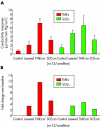A new insight into the cellular regulation of aqueous outflow: how trabecular meshwork endothelial cells drive a mechanism that regulates the permeability of Schlemm's canal endothelial cells
- PMID: 16234461
- PMCID: PMC1772935
- DOI: 10.1136/bjo.2005.081307
A new insight into the cellular regulation of aqueous outflow: how trabecular meshwork endothelial cells drive a mechanism that regulates the permeability of Schlemm's canal endothelial cells
Abstract
Aim: To test the hypothesis that trabecular meshwork endothelial cells (TMEs) increase the permeability of Schlemm's canal endothelial cells (SCEs) by actively releasing ligands that modulate the barrier properties of SCEs.
Methods: The TMEs were first irradiated with a laser light and allowed to condition the medium, which is then added to SCEs. The treatment response is determined by both measuring SCE permeability (flow meters) and the differential expression of genes (Affymetrix chips and quantitative polymerase chain reaction (PCR)). The cytokines secreted by the treated cells were identified using ELISA and the ability of these cytokines to increase permeability is tested directly after their addition to SCEs in perfusion experiments.
Results: SCEs exposed to medium conditioned by the light activated TMEs (TME-cm) respond by undergoing a differential expression (DE) of 1,120 genes relative to controls. This response is intense relative to a DE of only 12 genes in lasered SCEs. The TME-cm treatment of SCEs increased the SCE permeability fourfold. The role of cytokines in these responses is supported by two findings: adding specific cytokines established to be secreted by lasered TMEs to SCEs increases permeability; and inactivating the TME-cm by boiling or diluting, abrogates these conditioned media permeability effects.
Conclusion: These experiments show that TMEs can regulate SCE permeability and that it is likely that TMEs have a major role in the regulation of aqueous outflow. This novel TME driven cellular mechanism has important implications for the pathogenesis of glaucoma and the mechanism of action of laser trabeculoplasty. Ligands identified as regulating SCE permeability have potential use for glaucoma therapy.
Figures






References
-
- Hogan M, Alvarado J, Weddell J. Histology of the human eye: an atlas and textbook. Philadelphia: WB Saunders, 1971:1–687.
-
- Alvarado J, Betanzos A, Franse-Carman L, et al. Endothelia of schlemm’s canal and trabecular meshwork: distinct molecular, functional, and anatomic features. Am J Physiol Cell Physiol 2004;286:C621–34. - PubMed
-
- Alvarado J, Franse-Carman L, McHolm G, et al. The response of the meshwork cells to adrenergic agents and their antagonists. In: Krieglstein, ed. Glaucoma update IV. Heidelberg: Springer Verlag, 1991:9–19.
-
- Alvarado JA, Murphy CM, Franse-Carman L, et al. Effect of beta-adrenergics on paracellular width and fluid flow across outflow pathway cells. Invest Ophthalmol Vis Sci 1998;39:1813–22. - PubMed
Publication types
MeSH terms
Substances
LinkOut - more resources
Full Text Sources
Other Literature Sources
Medical
